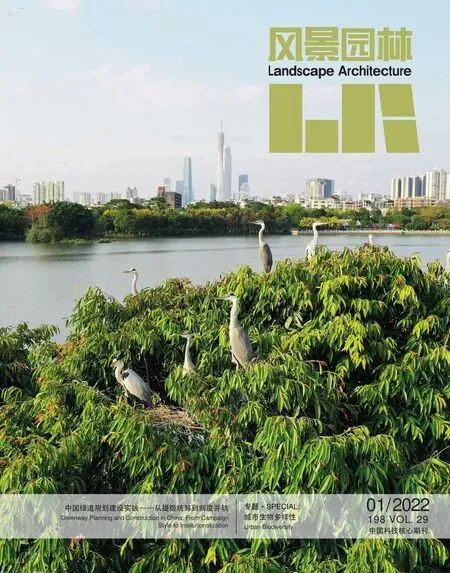城市生物多样性

城市并非只是给生物多样性带来威胁,人工与自然相互协调的城市生态系统也会为保护生物多样性提供机遇。人们普遍认为城市化是导致自然生态系统退化、生物多样性下降的直接原因。然而,城市生态系统同样拥有适应其复杂环境的本土物种,并且能够通过营造近自然的、稳定的栖息地来鼓励新的物种前来定居。此外,经过对城市生态系统进行科学的规划和修复,城市发展过程最初丧失的物种也有可能重新回到城市中来。近年来,北京通过大面积恢复湿地与林地生境、优化生态基础设施布局等措施,其生物多样性水平已位居世界大都市前列。就连曾经数量锐减的北京城“土著物种”雨燕,也在逐步适应北京的变迁,种群数量稳定在7 000余只,再现“旧时王谢堂前燕,飞入寻常百姓家”的情景。
风景园林学科能通过理论和实践为城市生物多样性保护做出重要贡献。
首先,通过建立完善的生态基础设施网络来保障城市生物多样性。许多动物可以在城市和郊区繁衍生息,这需要合理规划它们栖息的空间体系——城市生态基础设施网络。从数量的角度,城市绿地和水体是生物多样性的重要载体,只有足够的面积才能有效地保护城市的生物多样性;从结构的角度,加强生态廊道系统的建设,提升绿地的连通性,相当于增加动物到达栖息地的途径,有利于生物之间的迁徙与交流。也需要考虑到城市中建筑、道路桥梁、管道等灰色基础设施的分割作用,设置有助于生物迁徙的结构设施。
其次,通过营建多样化生境和构建多级生物链提升城市生物多样性。准确识别城市生境类型及空间分布规律、探明生物多样性本底,有助于增加生物多样性保护的生态边界划定以及生物多样性动态监控的科学性,进而持续营建生境和生物链。德国等欧洲国家广泛开展城市生境单元制图的理论与应用研究,此类探索能有力支持不同地区生物多样性的定向景观规划与管理。构成生态基础设施的植物生境是可供鸟类、昆虫和其他动物繁殖、居住和捕食的栖息地,合理选择能够承载复杂生物链的植物作为骨干树种,在城市中构建野生动物友好的生态链条。在美国巴尔的摩市,橡树能够为鳞翅目昆虫的幼虫、鸟类、水生无脊椎动物、鱼类等多达537类物种提供食物或栖息地,被认为是对野生动物非常友好的树种之一,因此当地规定1/2以上的种植乔木必须是橡树。提升城市生物多样性的策略对城市建设有广泛的借鉴意义。
再者,通过构建人与自然的联系,提升生物多样性价值对于人类社会的积极效益。作为与城市中的动植物共同生活的城市居民,在日常生活中都会不经意间接触到城市中的自然——街道的树荫、头顶的鸟群、草丛间的麻雀或者夏日傍晚的蝉鸣。越来越多研究证据表明此类与自然的接触会影响人们的健康、态度和行为,未来需要将研究领域扩展至生物多样性与社会功能关系的层面,剖析不同程度的生物多样性对城市居民产生影响的机制。通过持续发掘生物多样性对人与社会的影响力,构建不同的城市生物多样性模式,提升人类居住空间品质,为城市居民营造诗意栖居地。
风景园林学是以协调人与自然之间的关系为宗旨,保护和恢复自然环境,营造健康优美人居环境的学科。《生物多样性公约》第十五次缔约方大会(COP15)提出“生态文明:共建地球生命共同体”主题,为风景园林学科开展城市生物多样性保护提供了重大机遇。通过拓展以城市生物多样性保护为特征的学科理论,并推广应用到城市生态保护修复、适应气候变化的城市生态基础设施建设等具体行动中,从不同层面有意识地提升城市韧性并促进城市生物多样性保护规划,实现人与自然和谐共生的美好愿景。

Urban Biodiversity
Cities are not only a kind of menace to biodiversity, but also an opportunity for biodiversity in the urban ecosystem where manpower and nature inter-coordinate. It is widely believed that urbanization is the direct cause of natural ecosystem degradation and biodiversity decline. However, the urban ecosystem is similarly provided with native species adapted to their complex environments, and is able to create stable habitats close to nature to encourage new species to settle. In addition, with scientific planning and restoration of urban ecosystems, the species initially lost during urban development may be able to return to cities. Of recent years, Beijing has ranked among the world’s largest metropolises in terms of biodiversity through extensive restoration of wetland and woodland habitats and optimization of eco-infrastructure.Even swifts, the “indigenous species” of Beijing, whose number has once reduced sharply, have gradually adapted themselves to the changes in the city, and its population has stabilized at over 7,000,recreating the scene that “the swifts who lived under the eaves of Wang Xie’s hall are flying into ordinary people’s homes.”
The discipline of landscape architecture can make an important contribution to the protection of urban biodiversity through theory and practice.
Firstly, safeguard urban biodiversity by building up a sound eco-infrastructure network. Many animals can propagate in urban and suburban areas and it requires us to rationally plan the spatial system where they inhabit - the urban eco-infrastructure network.The green spaces and waters in the city are the important carriers of biodiversity from the quantitative perspective. Only with the sufficient area can urban biodiversity be effectively protected.From the structural perspective, consolidating the construction of eco-corridor systems and bettering the connectivity of green spaces amount to increasing the ways for animals to reach their habitats, conducive to migration and exchange among organisms.Consideration must also be given to the segmentation of gray infrastructure like buildings, roads, bridges and pipelines in the cities, and the structural facilities making for biological migration be built up.
Secondly, increase urban biodiversity through the creation of diverse habitats and the formation of multi-level bio-chains. The types of urban habitats and the patterns of spatial distribution should be identified accurately and the background of biodiversity ascertained, which can help improve the scientificity of delimiting the ecological boundary for biodiversity conservation and dynamically monitoring biodiversity, and thus sustain the building of habitats and bio-chains. Theoretical and applied research on mapping of urban habitat unit is widely conducted in Germany and other European countries. Such exploration can strongly support biodiversity-oriented landscape planning and management in different regions. The plant habitats that form eco-infrastructure are the homes where birds, insects and other animals can breed,live and feed. The plants that can carry complex bio-chains should be reasonably selected as backbone tree species to build wildlifefriendly eco-chains in the cities. In Baltimore, one of American cities, oak trees can provide food or habitats for over 537 species such as larvae of lepidopteran insects, birds, aquatic invertebrates and fishes, being considered one of the wildlife-friendly wood species, so more than 1/2 of the planted trees must be oak trees according to the local regulations. The strategy of improving urban biodiversity is of extensive reference significance for urban construction.
Thirdly, enhance the positive benefits of biodiversity value for human society by building a connection between people and nature. As the city dwellers who live with animals and plants in our cities, we are all inadvertently exposed to the urban nature in our daily lives - the shadows of trees on both sides of streets, flocks of birds overhead, sparrows among the grasses, or the chirping of cicadas on summer evenings. There is growing research evidence that such contact with nature will affect people’s health, attitudes and behaviors. The future research needs to be extended to the relationship between biodiversity and social function, dissecting the mechanism for the impact of different levels of biodiversity on urban residents. The impact of biodiversity on people and society should be explored ceaselessly and different models of urban biodiversity constructed to improve the quality of human living spaces and create poetic habitats for urban residents.
As a discipline that aims to harmonize the relationship between humans and nature, landscape architecture is to protect and restore the natural environment, and create a healthy and beautiful living environment. At the 15th Conference of the Parties (COP15) of theConvention on Biological Diversitywas brought forward the theme of “Ecological Civilization: Building a Community of Life on Earth”, which provides a major opportunity for this discipline to carry out urban biodiversity protection.Through extending its theories that feature the protection of urban biodiversity and applying them to concrete actions such as ecological protection and restoration of cities, and construction of urban eco-infrastructure for climatization, the urban persistence can be consciously enhanced and the planning of protecting urban biodiversity promoted at different levels so as to achieve a nice vision of harmonious coexistence between human beings and nature.
Editor-in-Chief: Professor ZHENG Xi
December 31, 2021

